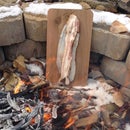Introduction: How to Connect Trailer Wiring: 2003 Chevy S-10 Pickup
The Plan: Borrow a tent-trailer and go camping
The Problem: No hitch and no electrical connection on my pickup
The Process: Install a hitch and an electrical connection compatible with the trailer
Step 1: The Easy Part: Install a Hitch
The 2003 Chevy S-10 bumper is completely adequate for hauling a tent-trailer, at least the one I borrowed from a friend. The bumper is labeled with two weight limits:
3500 LBS TRAILER LOAD MAXIMUM
350 LBS TONGUE LOAD MAXIMUM
The single-axle Coleman tent-trailer does not exceed these limits.
The trailer required a two-inch diameter ball hitch. My bumper was pre-drilled with a half-inch hole. I purchased a ball hitch rated at 3500 pounds, with a half-inch threaded stem. It fit perfectly in the bumper.
Step 2: The Harder Part: Install Wiring Harness
The Chevy S-10 pickup uses a snap connector to join the rear lights wiring with the electrical system. This location is a good place to splice in the trailer wiring connection.
Locate the connector under the rear of the pickup, on the driver-side, near the corner where the bumper joins the bed of the truck.
Step 3: Uncover the Wiring
Unwrap the wiring on the bumper-side of the connection, allowing you to see each individual wire.
Step 4: Identify the Wiring
Use a sharp-tipped electrical probe to identify which wire activates which light.
The red clip of the probe connects to the ground or common connection of the system, which could even be the steel frame of the pickup chassis.
Here the probe is connected to the frame of the chassis and the sharp tip pierces the first wire, the dark green. To provide a backing pad and avoid piercing a finger, use a stiff piece of cardboard.
While piercing the dark green wire, have an assistant activate the right turn signal. The probe should respond by flashing, indicating it is piercing the wire that carries electrical current to the right turn signal lamp.
Repeat with each wire in turn, noting how the probe responds with each activation of a function. You should end up confirming the following wire assignments:
Dark Green: Right Turn
Light Green: (Unused)
Solid Brown: Taillight
Yellow: Left Turn
White-striped Brown: Taillight
Step 5: Splice in the Trailer Wiring
Use a couple feet of four-wire flat ribbon wiring harness, with snap-fit splicing connectors.
Splice the brown wire of the trailer ribbon to the solid brown wire of the truck wiring.
Use pliers to force the metal tab into the connection, electrically joining the two wires.
Finish the splice by snapping the plastic tab in place.
Now, splice the same brown wire of the trailer ribbon to the white-stripped brown wire of the truck wiring. This connects both left and right taillights to the one brown wire of the trailer harness.
Splice the yellow wire of the trailer harness to the yellow wire of the truck wiring.
The ground wire screw attached to the steel chassis is also a good place to clip the electrical probe for testing.
Splice the green wire of the trailer harness to the dark green wire of the truck wiring.
Splice the white wire of the trailer harness to the black wire connected directly to the steel frame of the truck chassis. This is the ground or common connection for the entire electrical system.
Step 6: Test the Integrity of Each Splice
Probe each wire of the connected trailer harness while an assistant activates the turn signals and taillights. Taillights are activated by turning on the vehicle's parking lights. The probe should respond by lighting up when the appropriate wire is probed.
The ground wire connection is tested using a multimeter set to measure resistance: RX 1K Ohms.
The multimeter is connected inline with the ground wire on the truck chassis and the ground wire of the trailer harness.
Set the multimeter selector to measure resistance. Connect one lead to the ground screw of the pickup chassis frame. Connect the other lead to the bare copper wire at the end of the white wire of the trailer harness. If there is a good connection the multimeter will indicate nearly zero ohms of resistance, swinging the indicator needle all the way to the right.
Step 7: Secure the Wiring
A good way to secure the wiring is to enclose the trailer harness in protective cable covers. Add zip ties to secure the wiring to the frame.
The licence plate is illuminated by two small lamps. One of the lamps can be removed, allowing the trailer harness to be fed through the hole. Zip ties will keep the wiring in place.
The trailer I expected to borrow required a six-pole male round connector on the pickup.
The pole positions are standardized, making it easy to connect to the four wires of the trailer harness.
White: Connect to pole labeled GD
Brown: Connect to pole labeled TM
Yellow: Connect to pole labeled LT
Green: Connect to pole labeled RT
Before connecting the wires to the plug, be sure to slip the protective rubber boot over the harness. Consider using an underwriter's knot to prevent stress on the connections.
Another helpful technique is to tin each lead with solder. This helps provide a better contact with the screw-in pole connection.
With all four leads tinned, insert each in its correct connection and tighten the binding screw.
Slide the rubber boot up over the terminals.
The existing holes may allow the connector to be fastened, but be prepared to drill holes in the bumper to fit.
After the connection is mounted securely to the bumper, add more zip ties underneath.
Step 8: Finished!
With the connector secured inside and out, and the hitch bolted down, you're ready to hook up to the trailer and travel on down the road!
Step 9: Attribution
Images provided by the author, Milt Reynolds, Creative Commons License













